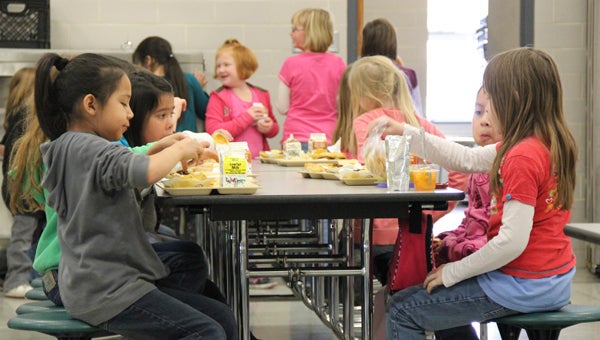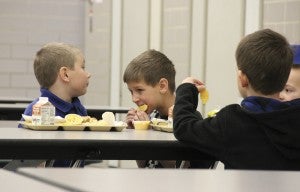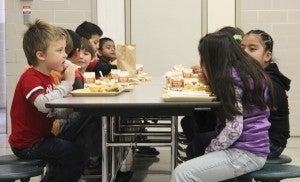Bullied: Bullying is elementary
Published 9:57 am Friday, December 10, 2010

Schools in the Albert Lea district are working toward having active adult supervision in areas where there are many students like lunchrooms or playgrounds. -- Kelli Lageson/Albert Lea Tribune
Editor’s Note: This is the fifth installment in a series about bullying.
Elementary school can be the place where children start having issues or rivalries with other students that can even not be resolved by high school. Unfortunately for the staff and administration at the elementary schools, many problems brought to them didn’t even start at the school. Often problems between students arise on the bus, walking home from school or on weekends.
“We see a lot of technology problems brought into school,” Sibley Elementary School social worker Dawn Berg said.
So far she has seen problems with social-networking sites like Facebook or texting among fifth- and sixth-graders. Berg said it’s often important to help educate parents and guardians about their role in problems with technology. She said the school hadn’t seen too many problems with technology, and she hopes that the program Sibley uses, Responsive Classroom, will help students with these problems.

Areas in the school where many children are together like lunchrooms, playgrounds or lockey bays sometimes make students feel less safe unless there is active adult supervision. -- Kelli Lageson/Albert Lea Tribune
Responsive Classroom is a program teachers have to be trained in to instruct. All the elementary schools in Albert Lea’s school district use the program. The program emphasizes making classrooms into communities. Most elementaries implement morning meetings where students and teachers can talk through problems or students can learn about conflict resolution.
“It’s meant to create a community and help kids be considerate and helpful, and I think that has long-term effects,” Berg said.
Sibley Principal Ross Williams said he thinks the program is an anti-bullying program in that it helps students feel connected to everyone in their classroom. He said the morning meetings are a lot like family meetings where anyone can air out problems or resolve conflicts.
“They have a chance to share in a comfortable atmosphere,” Williams said.
Williams and Berg agreed that they wouldn’t necessarily define teasing or name-calling as bullying until it gets to a certain point. Williams said they never ignore any problems brought to them, but that he doesn’t define some acts as bullying if they can be mediated and eradicated.
“There are different levels of understanding,” Williams said. “Bullying is a display of power over another person.”
Any actions like name-calling or teasing are teachable moments for the school. Williams said he likes to sit with both students and talk about the problem. He said if these smaller issues were ignored there would be much more bullying by his definition in the school.
At Lakeview Elementary School administrators feel the same way about problems between students.
“There’s an important distinction between bullying and peer-to-peer disagreement,” Principal Jean Jordan said.
She said she wants parents to know the school will help with any issue their child is having. She said the school has a no-acceptance policy with bullying, teasing or other acts of disrespect between children.

Students socialize during lunch at Halverson Elementary School Thursday. Lunchrooms and playgrounds in elementary schools are often where bullying in different forms appear if there isn't active adult supervision. At Halverson adults were helping students find places to sit and encouraging conversations. -- Kelli Lageson/Albert Lea Tribune
Jordan said that the school has benefitted from Responsive Classroom because it has helped build a culture of respect. Lakeview social worker Kim Anderson agreed that the best anti-bullying programs are culture-based.
“It’s the sense of belonging that stops violence and bullying,” Anderson said.
Lakeview went one step further when they started Lakeview Families about eight years ago. Each student who goes to the school is assigned to a family that includes all ages of students from kindergartners to sixth-graders. Anderson said she’s seen less instances of teasing between older and younger students. The families meet with the same teacher, and it helps students feel connected to the teacher and students in diffferent grades.
Jordan said that of course the school will always want to put a stop to bullying, but that empowering all students to have the tools to stop bullying will help as well.
“Kids feel helpless when they don’t have the skills or anyone to go to,” Jordan said.
She said she hopes their programs teach students the options available to help stop bullying like walking away from a bully or talking to a trusted adult.
Jordan and Anderson agreed that most of bullying or teasing is verbal at their school. Berg also said that verbal problems far outweigh physical bullying at Sibley.
“It can be more relational aggression especially with girls and gossiping and rumors,” Berg said.
Berg also said many problems get brought to the school from the bus or from when students are walking home together. She said she rode a bus once to observe the students’ behavior and said she was surprised at the behavior she saw from students who act much differently than they do in the classroom.
She said it can be difficult to help the problem because there will never be active adult supervision on buses because the bus driver’s job is to drive the bus safely. The driver isn’t able to resolve conflicts. Berg said she’s hoping to discuss bus behavior during some morning meetings so students can learn conflict resolution.
“Before school on the playground is the most vulnerable area,” Berg said.
She said they’ve been addressing this issue and that prevention is one of the most important parts of the problem.
“We’d much rather teach skills than wait for problems,” Berg said.
Jordan also said areas without supervision like buses or playgrounds before or after school are a problem. She said they’re working on teaching how to deal with those issues by having structured play time during recesses.
Jordan also said she understands that parents are frustrated when she can’t talk about how other students are being punished or reprimanded. She said how the school deals with problems is confidential, which can make some parents think that they’re not being dealt with.
“I think by and large the parents trust us,” Jordan said.
She said the school will not condone bullying and that the only way to work on it is to keep teaching the students.
“We teach and re-teach,” Jordan said.
Albert Lea High School
Administrators in the elementary schools hope the values and conflict resolution techniques they are teaching will help the students when they are older, but as Jordan said, students often need to be re-taught these life skills.
Currently the high school doesn’t have much class time dedicated to anti-bullying or any schoolwide activities planned that could potentially diminish the amount of bullying that occurs.
Principal Al Root said the high school needs to do more to train students. He hopes that the advisory program helps some students. Students are assigned to a group of students and a teacher for all four years while they’re at high school. The hope is that they’ll connect with the other students and the teacher and feel that they have someone they can talk to in the school.
“We tell them if they’re being harrassed to go to the first person they see,” Root said.
He said he has had reports of some racial, sexual and religious bullying but said it’s minimal. Most of the bullying issues at the high school are based on students bullying students who are different from them.
He said students in high school are at a difficult age and often don’t know how to deal with the problems in their lives. They’ll bring problems from home to school and act out.
“We need to be more proactive,” Root said.
He said he likes to be able to teach students the skills to work out conflicts without aggression or yelling. Root said many students don’t want to talk or don’t know how to communicate effectively.
One program at the high school works to involve freshmen in everyday activities. A Link Crew is assembled at the end of the school year made up of juniors and seniors. They work together to plan for orientation. At orientation two crew members are assigned a group of freshmen. This group meets throughout the year during advisory periods.
“They do an activity like where to get help at the high school,” Link Crew coordinator Mindy Kruger said.
Kruger and fellow teacher Kevin Gentz are the coordinators. Kruger has been involved in the Link Crew since it began four years ago. Kruger said the Link Crew students will share personal experiences with the freshmen, which hopefully will help them assimilate.
The Link Crew also plans events that aim to get the freshmen out to typical high school experiences. One such event was to plan a free dinner and free admission to Tiger’s Roar event, and others include a tailgating event before a football game where the student could eat and go to the game for free. Kruger understands that not all freshmen will become best friends with the upper classmen, but the hope is that the freshmen will have someone to talk to and look up to.
“I think it’s been successful,” Kruger said.
Administrators deal with problems as they arise, but often the problems aren’t reported or come to the administrators much later than they would hope.
“It goes on for a while before they’ll tell anyone,” Root said. “We can’t help with bullying if they don’t ask.”
He said another problem is that much of the bullying happens outside of the school, during evenings or weekends. He said mediation sometimes works well, unless there’s a long history of bullying between the students.
Root said when he sees students who don’t have a peer group or who are lonely that it worries him.
High school Social Worker Jennifer Braaten said much of the problem is girls being mean to one another. She said she usually sits down with both girls and they all talk about the problem, which sometimes works. She also said some problems are carried over from middle school, which can make it hard for her to mediate.
“There will always be conflict,” Braaten said.
She said how the school deals with the conflict is the key. If it’s not resolved then they missed a teachable moment to help the student learn life skills.
Root said he thinks high schoolers especially have a hard time with relationships. In high school students are starting to date and often problems arise between girls.
The police liason officer at the high school, Ted Herman, said he’s continually surprised at how mean girls can be to one another. When he deals with problems he makes sure parents are involved and know about the issue. Then he usually talks with both students to work out the problem.
“When you get to the root of the problem it works itself out,” Herman said.
He thinks it’s vitally important for parents and the school to work together with problems like bullying. He said adding life skills to the list of things teachers need to educate students on is overwhelming and that communities should be involved in how all children are raised.
Root said the high school is lucky in that if problems were to get to the point where they couldn’t be resolved students could transfer to the Area Learning Center. There they can be more independent and get their education in a different way.
“They’re transferring not only because they’re being bullied,” Root said.
He said students often transfer if they have attendance problems at the high school.
Administrators agree that technology has made bullying much easier. With Facebook and texting available to much of the student body, problems that arise are often brought to school.
“People seem to be tougher when they’re not face-to-face,” Herman said.
He said he thinks if parents were to moniter their child’s Facebook account or cell phone that many problems would go away.
Next week: View the winning entries in the Tribune’s contest that asked for ideas about how to stop bullying.



